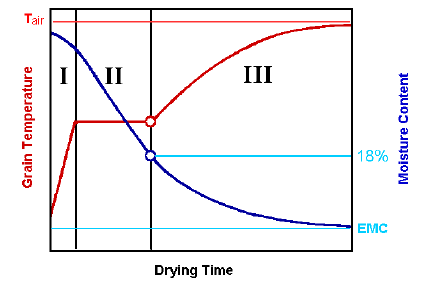Fundamentals of grain drying
Drying of grain involves exposing grain to air with low relative humidity (RH) which will lead to evaporation of the moisture in the grain and then the moisture’s removal away from the grain. Since drying practices can have a big impact on grain or seed quality, it is important to understand some fundamentals of grain drying.
Moisture removal
In paddy grain, moisture is present at two places: at the surface of the grain, ‘surface moisture’, and inside the kernel, ‘internal moisture’. Surface moisture will readily evaporate when grain is exposed to hot air. Internal moisture evaporates much slower because it first has to move from the kernel to the outside surface. As a result, surface moisture and internal moisture evaporate at a different rate. This difference results in a different ‘drying rates’ for different period of drying. The drying rate is defined as the rate at which grain moisture content declines during the drying process. It is normally expressed in percent moisture removed per hour [%/hr]. Typical drying rates of rice dryers are in the 0.5%/hr to 1%/hr range.
A drying curve, as illustrated in the figure below, shows how the grain moisture content (MC) and grain temperature change over time. As can be seen in the chart, the drying rate is not constant but changes over time. The temperature of the grain equally changes over time.

Drying periods and implications optimal drying
There are three different drying periods which will occur consecutively in time:
- Preheating period (drying rate is almost 0): When wet grain is exposed to hot air, initially only a very slight change in MC is observed. This happens because all the heat provided in the drying air is used to heat up the grain to the drying temperature.
- Constant-rate period (drying rate is constant in time): Once the grain is at the drying temperature, water starts to evaporate from the surface of the grain. During this period, all the heat from the drying air is used to evaporate surface moisture and the amount of moisture removed from the grain is constant in time. It is therefore called the constant-rate period. During this period, grain temperature is constant as well.
- Falling-rate period (drying rate declines over time): As time passes, it takes more time for internal moisture to appear at the surface, and evaporation of water is no longer constant in time. As a result, drying rate will decline, and some of the heat from the drying air will heat up the grain. For paddy grain, the falling-rate period typically occurs at around 18% grain moisture content.
By using the 18% MC and the drying curve characteristics as a guideline, a few recommendations can be made in regard to grain drying procedures. These guidelines can be used regardless whether grain is dried in the sun or by using artificial grain dryers.
Drying rate and temperature
Above 18% MC the grain drying rate can be increased (that is, drying will occur faster) by providing a higher temperature or more drying air without major changes in grain temperature. Below 18%MC increase in drying air temperature will not increase the drying rate but will increase grain temperatures and potentially damage the grain. Therefore, higher drying air temperatures can be used to dry grain quickly down to 18% MC (to remove "surface moisture") but lower temperatures should be used to remove internal moisture from the grain.
For seed purposes, drying air temperatures should never exceed 43ºC, regardless of the MC, to avoid overheating of the grain which kills the germ. Exposing paddy to 60ºC for one hour can reduce the seed germination rate from 95% to 30%. Two hours at 60ºC will reduce the germination rate to 5%.
Uniform drying
During the drying process there is always variability in MC of individual grains. Especially in fixed-bed dryers the grains at the air inlet dry faster than at the air outlet resulting in a moisture gradient in the grain bulk at the end of the drying process. For production of good quality grain or seed, this variability should be kept as low as possible. Frequent stirring in sun drying, grain turning in fixed bed dryers or circulation in re-circulating batch dryers will improve uniformity of drying, minimize the re-wetting of dried grains and thus maintain grain quality.
Tempering
When the drying of grain is temporarily stopped the moisture within the grain equalizes due to diffusion. When drying is restarted, the drying rate becomes higher compared to continuous drying. The process of stopping intermittently is called tempering. In addition during tempering the moisture differences between grains equalize. Tempering therefore also ensures that moisture gradients in the grain bulk that develop during drying in certain dryer types are minimized.
To maintain grain quality, including a tempering period is recommended to allow for redistribution of internal moisture in the grain. In modern re-circulating grain dryers, grain is not dried continuously but goes through a cycle of drying followed by tempering. This improves drying rates, grain quality and reduces energy costs.










